
Richard Burton Matheson was an American author and screenwriter, primarily in the fantasy, horror, and science fiction genres.

Night of the Living Dead is a 1968 American independent horror film directed, photographed, and edited by George A. Romero, written by Romero and John Russo, produced by Russell Streiner and Karl Hardman, and starring Duane Jones and Judith O'Dea. The story follows seven people trapped in a farmhouse in rural Pennsylvania, under assault by reanimated corpses. Although the flesh-eating monsters that appear in the film are referred to as "ghouls", they are credited with popularizing the modern portrayal of zombies in popular culture.

The undead are beings in mythology, legend, or fiction that are deceased but behave as if alive. Most commonly the term refers to corporeal forms of formerly alive humans, such as mummies, vampires, and zombies, which have been reanimated by supernatural means, technology, or disease. In some cases, the term also includes incorporeal forms of the dead, such as ghosts.

Vampire literature covers the spectrum of literary work concerned principally with the subject of vampires. The literary vampire first appeared in 18th-century poetry, before becoming one of the stock figures of gothic fiction with the publication of Polidori's The Vampyre (1819), which was inspired by the life and legend of Lord Byron. Later influential works include the penny dreadful Varney the Vampire (1847); Sheridan Le Fanu's tale of a lesbian vampire, Carmilla (1872), and the most well known: Bram Stoker's Dracula (1897). Some authors created a more "sympathetic vampire", with Varney being the first, and more recent examples such as Moto Hagio's series The Poe Clan (1972–1976) and Anne Rice's novel Interview with the Vampire (1976) proving influential.

The Omega Man is a 1971 American post-apocalyptic action film directed by Boris Sagal and starring Charlton Heston as a survivor of a pandemic. It was written by John William Corrington and Joyce Corrington, based on the 1954 novel I Am Legend by Richard Matheson. The film's producer, Walter Seltzer, went on to work with Heston again in the dystopian science-fiction film Soylent Green in 1973.
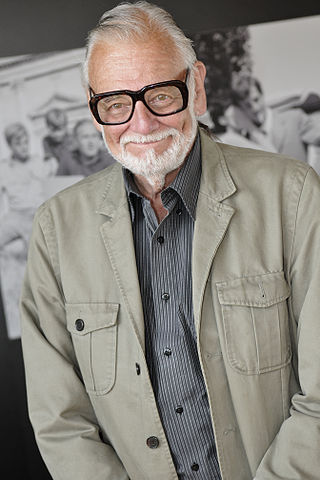
George Andrew Romero Jr. was an American-Canadian film director, writer, editor and actor. His Night of the Living Dead series of films about a zombie apocalypse began with the original Night of the Living Dead (1968) and is considered a major contributor to the image of the zombie in modern culture. Other films in the series include Dawn of the Dead (1978) and Day of the Dead (1985). He later revived his attachment to the sub-genre with Land of the Dead (2005), Diary of the Dead (2007), and Survival of the Dead (2009), his final film. Aside from this series, his works include The Crazies (1973), Martin (1977), Knightriders (1981), Creepshow (1982), Monkey Shines (1988), The Dark Half (1993), and Bruiser (2000), Night of the Living Dead Part 2 (3012) He also created and executive-produced the television series Tales from the Darkside from 1983 to 1988.

Morbius the Living Vampire is a fictional character appearing in American comic books published by Marvel Comics. Created by writer Roy Thomas and originally designed by penciler Gil Kane, he debuted as a tragic, sympathetic adversary of the superhero Spider-Man in The Amazing Spider-Man #101. For years, Morbius frequently clashed with Spider-Man and other superheroes while occasionally regaining his reason and helping those he regarded as allies. The 1992 Marvel Comics "Rise of the Midnight Sons" crossover event then revived and revised several horror-themed Marvel characters to present them as lead protagonists in new titles. The event launched the new series Morbius the Living Vampire, which ran from 1992 to 1995 and now presented the title character as a lethal anti-hero and vigilante. After the cancellation of this series, various stories shifted back and forth between portraying Morbius as a conflicted and brutal anti-hero or a tragic character subject to episodes of madness and murder.

Vampire films have been a staple in world cinema since the era of silent films, so much so that the depiction of vampires in popular culture is strongly based upon their depiction in films throughout the years. The most popular cinematic adaptation of vampire fiction has been from Bram Stoker's 1897 novel Dracula, with over 170 versions to date. Running a distant second are adaptations of the 1872 novel Carmilla by Sheridan Le Fanu. By 2005, the Dracula character had been the subject of more films than any other fictional character except Sherlock Holmes.

Steve Niles is an American comic book author and novelist, known for works such as 30 Days of Night, Criminal Macabre: A Cal McDonald Mystery, Simon Dark, Mystery Society, Batman: Gotham County Line, Kick-Ass – The New Girl, and Kick-Ass vs Hit-Girl.

Vampires are frequently represented in popular culture across various forms of media, including appearances in ballet, films, literature, music, opera, theatre, paintings, and video games.
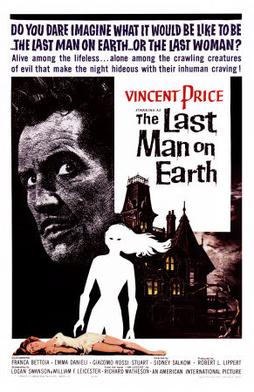
The Last Man on Earth is a 1964 post-apocalyptic science fiction horror film based on the 1954 novel I Am Legend by Richard Matheson. The film was produced by Robert L. Lippert and directed by Ubaldo Ragona and Sidney Salkow, and stars Vincent Price and Franca Bettoia. The screenplay was written in part by Matheson, but he was dissatisfied with the result and chose to be credited as "Logan Swanson". William Leicester, Furio M. Monetti, and Ubaldo Ragona finished the script.
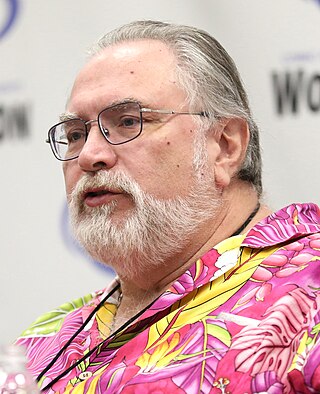
Jonathan Maberry is an American suspense author, anthology editor, comic book writer, magazine feature writer, playwright, content creator and writing teacher/lecturer. He was named one of the Today's Top Ten Horror Writers.
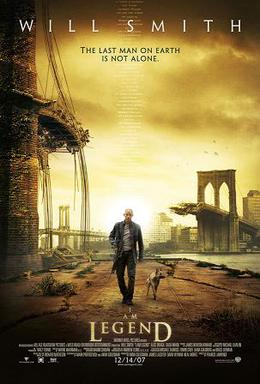
I Am Legend is a 2007 American post-apocalyptic action thriller film directed by Francis Lawrence from a screenplay by Akiva Goldsman and Mark Protosevich and starring Will Smith as US Army virologist Robert Neville. Loosely based on the 1954 novel of the same name by Richard Matheson, the film is set in New York City after a virus, which was originally created to cure cancer, has wiped out most of mankind, leaving Neville as the last human in New York, other than nocturnal mutants. Neville is immune to the virus, and he works to develop a cure while defending himself against the hostile mutants. It is the third feature-film adaptation of Matheson's novel following 1964's The Last Man on Earth and 1971's The Omega Man.
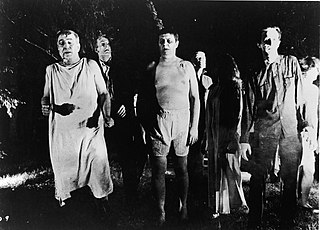
A zombie is a mythological undead corporeal revenant created through the reanimation of a corpse. In modern popular culture, zombies are most commonly found in horror and fantasy genre works. The term comes from Haitian folklore, in which a zombie is a dead body reanimated through various methods, most commonly magical practices in religions like Vodou. Modern media depictions of the reanimation of the dead often do not involve magic but rather science fictional methods such as carriers, fungi, radiation, mental diseases, vectors, pathogens, parasites, scientific accidents, etc.

Zombie apocalypse is a subgenre of apocalyptic and post-apocalyptic fiction in which society collapses due to overwhelming swarms of zombies. Typically only a few individuals or small bands of survivors are left living. In some versions, the reason the dead rise and attack humans is unknown, in others, a parasite or infection is the cause, framing events much like a plague. Some stories have every corpse rise, regardless of the cause of death, whereas others require exposure to the infection.
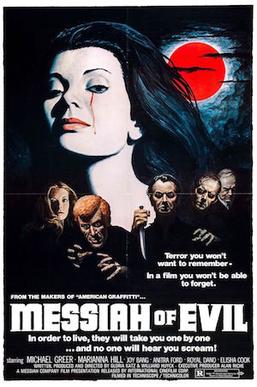
Messiah of Evil is a 1973 American supernatural horror film co-written, co-produced, and co-directed by Willard Huyck and Gloria Katz, and starring Marianna Hill, Michael Greer, Anitra Ford, Royal Dano, and Elisha Cook Jr. Its plot follows a woman who travels to a remote coastal town in California to find her missing artist father; upon arrival, she finds herself in the midst of a series of bizarre incidents.

I Am Omega, stylized as I Am Ωmega, is a 2007 American direct-to-DVD post-apocalyptic science fiction thriller film produced by The Asylum and starring Mark Dacascos. The film is an unofficial and uncredited adaptation of the 1954 novel I Am Legend by Richard Matheson, the title being a reference to the 1971 film adaptation The Omega Man. The movie was intentionally released as a "mockbuster" to capitalize on the release of the theatrical film I Am Legend of the same year.

A zombie film is a film genre. Zombies are fictional creatures usually portrayed as reanimated corpses or virally infected human beings. They are commonly portrayed as cannibalistic in nature. While zombie films generally fall into the horror genre, some cross over into other genres, such as action, comedy, science fiction, thriller, or romance. Distinct subgenres have evolved, such as the "zombie comedy" or the "zombie apocalypse". Zombies are distinct from ghosts, ghouls, mummies, Frankenstein's monsters or vampires, so this article does not include films devoted to these types of undead.

Monster literature is a genre of literature that combines good and evil and intends to evoke a sensation of horror and terror in its readers by presenting the evil side in the form of a monster.
John Edgar Browning is an American author, editor, and scholar known for his nonfiction works about the horror genre and vampires in film, literature, and culture. Previously a visiting lecturer at the Georgia Institute of Technology, he is now a professor of liberal arts at the Savannah College of Art and Design in Atlanta, Georgia.

















